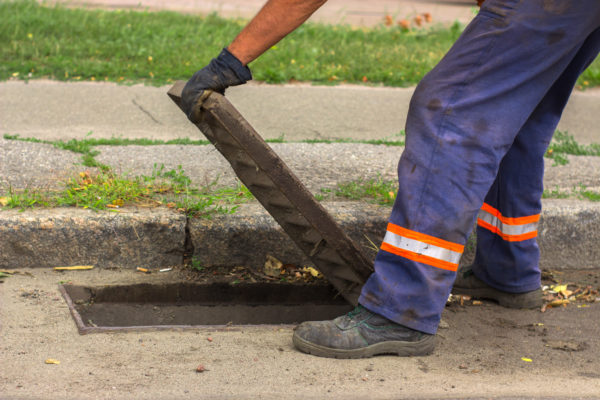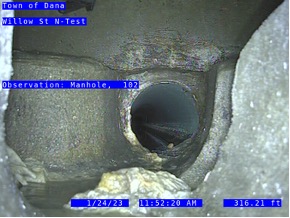RCAP’s Condition Assessment Team Offers Expertise to Rural Communities in Ohio

The aftermath of a storm can turn a community upside down. When stormwater and groundwater enter a sewer system, the inflow and infiltration (I&I) can cause overflows and sewage backups, increase wear and tear on the system, and produce enormous quantities of dirty water that strain the capacity of treatment facilities. In systems with significant I&I issues, even modest rain events can overwhelm collection and treatment systems.
The Great Lakes Community Action Partnership (GLCAP) condition assessment team in Ohio brings clarity to rural communities in desperate need.
The GLCAP Condition Assessment Team in Ohio helps small systems tackle the environmental challenges of summer downpours by helping them find the most critical problem areas of a system, strategically target repair and replacement dollars, and plan for future improvements. Since 2018, the GLCAP team has delivered condition assessment services to dozens of small systems.
Through generous grants from the Ohio Water Development Authority, Rural Community Assistance Partnership (RCAP) acquired equipment to conduct condition assessment. This includes: a 3D LiDAR scanner for manhole inspections, acoustical testing equipment for rapid assessment of sewer mains, self-propelled and push cameras for sewer line inspection, advanced inspection management software, smoke testing equipment, sewer flow loggers, GPS equipment, rugged tablets, and associated safety gear. The equipment, in conjunction with the RCAP GIS team’s web and mobile data collection apps, makes for an exceptional field data collection and reporting program that can help small systems plan to lessen future environmental impacts.
Conducting Condition Assessment
Condition assessment evaluates the current state of a community’s water and wastewater infrastructure, helps estimate remaining useful life expectancy, and identifies the areas most in need of cleaning and repair. A typical visit might involve identifying potential sources of I&I utilizing flow tracking, smoke testing, and pipe inspections. This allows RCAP to provide insight into the origin of I&I, document problem areas, and recommend customized solutions.
Manhole inspections, which are key for understanding the overall health of a sewer system, can be time consuming and generate a large of amount of data. Using the 3D LiDAR manhole scanner, RCAP improves efficiency in the field and collects higher quality data, with videos and 360-degree images offer communities an unparalleled view of their manhole structures. Standardized reporting methods and simple viewer programs ease the process of sorting and reviewing large quantities of inspection data.
Valves, another key component of every water utility system, provide the first line of defense for controlling the impact of distribution system disruptions. Managing valves requires assessment of their condition, and a valve exercising plan supports cyclical maintenance. RCAP provides the labor, mechanical tools, mapping, data collection, and summary reporting crucial to the process. Summary reports show the impact of maintenance efforts, meet regulatory standards, and support decision making for replacement schedules.
Tackling I & I Threats
In Adelphi, Ohio, a village about 70 miles north of the Kentucky border, staff working on a stormwater master plan called on RCAP to investigate I&I in the village sewer system. “Adelphi was in a really tough financial position,” explained Ben Howard, RCAP Senior Rural Development Specialist. “The village has a collection-only sewer utility which sends flows to neighboring Laurelville for treatment, so any I&I is costly.” Adelphi pays for every gallon of wastewater treated by Laurelville. When I&I enters the sewer collection system, it increases the number of gallons that are delivered to Laurelville, which in turn increases Adelphi’s bill.
The poor condition of the sewer system made it difficult to move forward with a stormwater plan, so the condition assessment team traveled to Adelphi to conduct some field investigation. They used the 3D LiDAR scanner tool and self-propelled crawler camera unit to scan and capture detailed images from inside manhole walls and sewer lines. They also used the acoustic rapid assessment tool to check for pipe blockages and aid in mapping the community sewer.
“The acoustic rapid assessment tool scores the condition of sewer lines based on the successful transmittance of sound from one manhole to the next,” Ben explained. “Most scored relatively well. Those that scored poorly were revisited near the center of town where there were signs of water backing up into manholes (surcharging). Then we used the crawler camera to see as far as we could.”
RCAP was able to identify the problem area where water was backing up due to settled-out debris in the center part of town. The village will likely use a vacuum truck to remove the debris. RCAP also followed up with smoke testing to detect inflow from private property.
Once RCAP staff know the full nature of the problem, they can work with a system’s consulting engineer to obtain a scope of work and estimate the cost to complete necessary repairs and improvements. By understanding what it costs to fix the problem, RCAP can help communities prioritize and develop a project timeline, seek board or council approval to pursue grants and subsidized loans for the project, and apply for funding.
I&I take away capacity within collection systems and burden a wastewater treatment plant’s ability to efficiently process sewage. Stormwater issues abound in rural communities whose assets are chronically in danger of disrepair when municipal budgets run dry. But if a wastewater utility can eliminate excess sources of stormwater, it will reduce chemical, electrical and capital costs.

